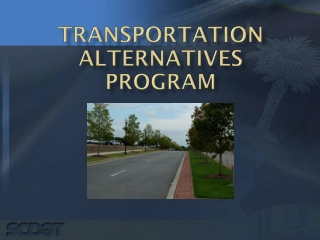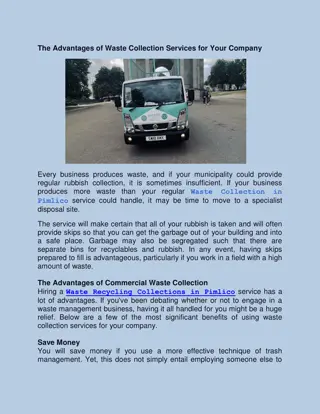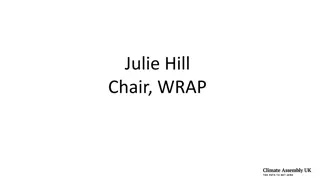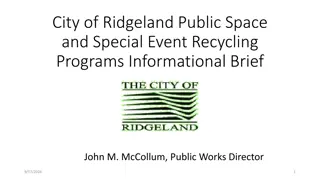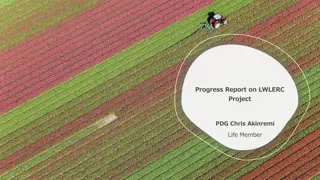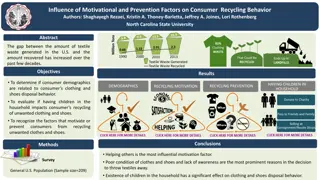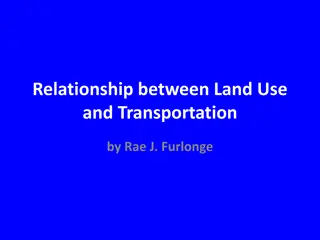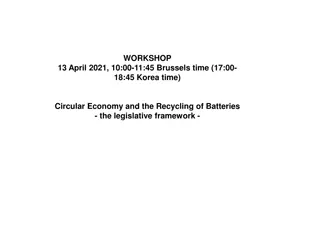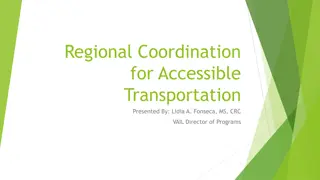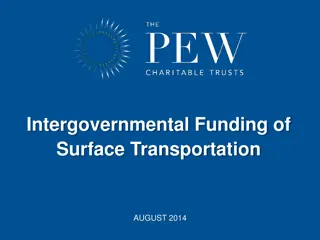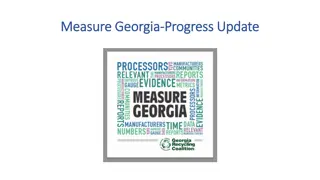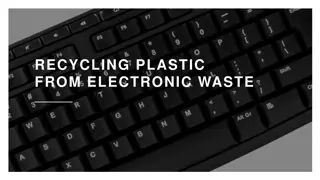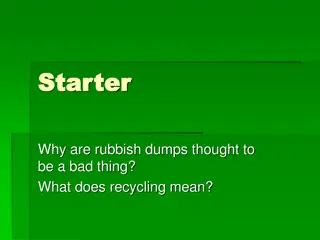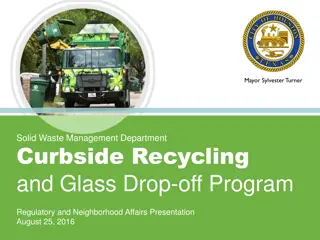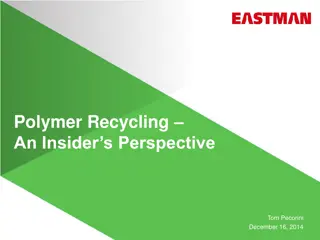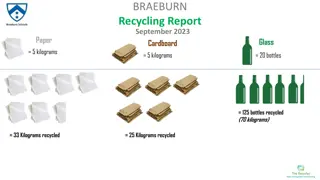Exploring Land Value Return and Recycling for Transportation Funding
With transportation investment needs surpassing available resources, investigating the potential of land value return and recycling as a revenue source can benefit public agencies. This involves recovering and reusing a portion of the increased land value generated by public investment in transportation infrastructure. The approach is distinct from broader value capture methods, focusing on the equitable distribution of societal value created by transportation infrastructure investment.
Download Presentation

Please find below an Image/Link to download the presentation.
The content on the website is provided AS IS for your information and personal use only. It may not be sold, licensed, or shared on other websites without obtaining consent from the author. Download presentation by click this link. If you encounter any issues during the download, it is possible that the publisher has removed the file from their server.
E N D
Presentation Transcript
Land Value Return and Recycling to Fund Transportation NCHRP PROJECT 19-13 September 21, 2017
Purpose With transportation investment needs significantly outweighing available resources, exploring land value return and recycling (land value return) a largely overlooked revenue source could benefit the public agencies that build, maintain, and operate the transportation system. 2
Agenda Defining Land Value Return and Recycling (Land Value Return) What Is Land Value Return and Recycling (Land Value Return)? Is Land Value Return the Same as Value Capture? Why Land Value Return? What Is Land Value Return-Like Like ? How Does Land Value Return Work? Implementation Considerations What Are the Policy Considerations? What Are the Keys to Stakeholder Support? What Are the Strategies to Develop Stakeholder Support? What Are the Key Steps to Implementation? What Are the Potential Rewards? For More Information 3
What Is Land Value Return and Recycling? An overlooked revenue source for transportation Well-performing transportation infrastructure can increase nearby land value (as a result of higher willingness to pay) Land value return and recycling funding methods: o Enable the public recovery and reuse of a portion of the increased land value created by public investment in transportation infrastructure Note: For remainder of presentation, Land Value Return and Recycling is shortened to Land Value Return 5
Is Land Value Return the Same as Value Capture? Land value return is a subset of what is commonly referred to as value capture Value capture encompasses a broader range of funding methods related to real estate that do not always involve the public recovery of publicly created land values Land value return limits the definition to methods that recover publicly created values publicly created land Capture does not reflect how land value return methods result in a more equitable distribution of the societal value created by transportation infrastructure investment 7
Why Land Value Return and Recycling? Overlooked source of funding for transportation Recovers a portion of increased land values from landowners that benefit uniquely and directly Results in a more equitable distribution of the monetary benefits of well-performing transportation facilities Enhances environmental and financial sustainability of land use and transportation infrastructure 8
Why Land Value Return and Recycling, cont.? Adheres to beneficiary pays principle 9
Why Land Value Return and Recycling, cont.? Can help achieve public policy goals related to sustainable economic and land development, environment, and transportation system performance o Encourages development where land values are high (fees are the same on developed and undeveloped parcels) o Removes incentives for land speculation o Encourages more rational growth and development 10
Land Value Return versus Land Value Return- -Like Like? Recognizing interest in topic is driven by ability to generate funding; funding methods presented are not limited to those defined as land value return Land Value Return-Like Like methods o Provide additional transportation funding methods related to real estate o Involve a fee on property values (on land and privately created building value jointly) or or other metric related to actual land use and development activity (like trips generated) o Do not have the same incentive effects as land value return o Differ with regard to effects on economic development, transportation, and land use goals and policies 11
How Does Land Value Return Work? The Methods Land Value Return Land Value Return-Like Land Value Tax or Split Rate Tax Transportation Utility Fee Betterment Levy Tax Increment Financing Special Assessment Districts Development Impact Fee Sale of Public Land or Public Air Rights Exaction or Proffer Lease of Public Land or Public Air Rights Joint Development Fee & Interface Fee 12
Land Value Return: Land Value Tax or Split Rate Tax Land Value Tax or Split Rate Tax Overview: Case Example: McKeesport, Duquesne, and Clairton, PA Distressed suburban Pittsburgh cities with year-over- year decline in building permits McKeesport adopted split rate tax; building permits increased Variants of traditional property tax Split Rate Tax: Land is taxed at a higher rate than improvements Land Value Tax: Only land is taxed (no tax on improvements) Revenues paid for locality s general expenses including local transportation projects and, in rare cases, state projects Increased infill development reduced transportation needs 13
Land Value Return: Betterment Levy Betterment Levy Overview: Case Example: Bogot , Columbia One-time payments on actual (or estimated) increase in land value resulting from new or improved infrastructure Funds road and bridge improvements Levy assessed on all properties affected by a project (or set of projects, such as a corridor) Not implemented in the U.S. to date and limited international examples Levy amount calculated based on benefit factors (travel speeds, land use changes, real estate market value, integration into urban structure, circulation optimization, depressed area recovery) Typically, levy capped at cost of the project 14
Land Value Return: Special Assessment Districts Special Assessment Districts Case Example: State Route 28 Transportation Improvement District, Fairfax and Loudoun Counties, VA Overview: A defined geographic area determined to benefit from an infrastructure investment Project improves access to properties in corridor District formed by petition of commercial and industrial property owners of at least 51% of the land area or assessed value Property owners are charged a fee or tax on their property s assessed land* value (in addition to property tax) Up to a $0.20 surcharge per $100 of assessed value levied on commercial and industrial property tax bills Also known as benefit districts, improvement districts, business development districts, special service areas, etc. Revenues support bonds that cover 75% of project cost (Virginia DOT covers 25%) *Note: If the assessment is based on land value, special assessment districts are land value return. If the assessment is based on the value of land and improvements, they are land value return-like. This example showcases a context where assessment is based on both land and improvements, so it is land value return-like. There are no special assessments in the country based on land value. Funds several Route 28 corridor projects (intersection upgrades to grade separated interchanges, widening) by providing debt service finance for those projects 15
Land Value Return: Sale or Lease of Public Land or Air Rights Sale or Lease of Public Land or Air Rights Overview: Case Example: Copley Place, Boston, MA Air Rights Lease Sale or lease of publicly owned land or air rights at market value Mixed-use joint development on 9.5-acre site over Massachusetts Turnpike Leases provide ongoing income streams and opportunity to renegotiate terms at end of lease (unlike a one-time sale) Turnpike Authority leased air rights for 99 years to developer Leasing retains public ownership Turnpike Authority used revenue for capital, operating, and maintenance expenses of the turnpike Sales provide upfront capital infusion Income streams allow revenue sharing agreements between multiple agencies Reconnected urban neighborhoods of city, which were divided by the turnpike 16
Land Value Return: Joint Development Fee & Interface Fee Joint Development Fee & Interface Fee Overview: Case Example: High Street Cap, Columbus, OH Joint Development and Air Rights Lease Cooperative undertaking of a development project by a public agency and a private developer Retail development with main street design on air rights above I-670 Often includes sale or lease of public land or air rights Federal funds were used to acquire the real estate as part of I-670 construction; FHWA sought to ensure appropriate payment for its use Joint development fee: Paid to government for ability to develop public land or air rights adjacent to a transportation facility Interface fee: Paid to government for ability to create/maintain direct connection from private property to a transit facility Restrictions on use of air rights platform made determining fair market value complex FHWA agreed to an unconventional base rent with a profit sharing component Works when there are no restrictions between real estate development and agency land use actions 17
Land Value Return-Like Transportation Utility Fee Transportation Utility Fee Like: Overview: Case Example: Pavement Maintenance Utility Fee, Oregon City, OR Ongoing fees to pay for transportation operation and maintenance costs (in theory, also could fund capital costs) Monthly charge collected through regular utility bill from residences and businesses Paid by real estate occupants based on Based on number of trips a particular land use generates using Institute of Transportation Engineers data o Intensity and type (commercial, residential) of use Fee was phased in over several years to lessen immediate burden o Assumptions about utilization of transportation (i.e., number of trips generated, apartments, parking spaces, etc.) Jurisdiction wide or within a benefit area 18
Land Value Return-Like Tax Increment Financing Tax Increment Financing Like: Overview: Case Example: Transportation Reinvestment Zones, El Paso, TX Captures all or part of future tax revenue increases above a base level within a designated geographic area that will benefit from a transportation investment Texas municipalities may designate contiguous zones in which they promote a specific transportation project Can collect increases in a variety of existing taxes (i.e., property taxes, sales taxes, hotel and restaurant taxes, and other taxes) A base year is established and, thereafter, a portion of incremental property tax revenue within the zone funds a portion of the project s cost No new taxes or fees imposed; instead, revenue is segregated for dedicated transportation use El Paso used such zones to generate revenue for over $400 million in projects in 2008 plan Can limit availability of tax revenues for other municipal investments and services Revenue used as loan collateral in the financing of transportation projects in the zone. 19
Land Value Return-Like Development Impact Fees Development Impact Fees Like: Overview: Case Example: Transportation System Development Charges (TSDC), Portland, OR Oregon statutes authorize TSDC and require: o Adopting a capital plan designating investments o Calculating TSDC as a reimbursement fee for existing improvements with capacity or an improvement fee for future improvements One-time charges to cover costs incurred by the public sector in providing needed infrastructure including transportation to serve a new development Payment is a condition for obtaining development permits City identified a list of growth-oriented, multi- modal projects to guide spending TSDC revenues for 10 to 20 years Amount of fee must be related to and proportional to the anticipated additional public infrastructure costs required by new private development Rate is based on number of trips the development is expected to create 20
Land Value Return-Like Exactions and Proffers Exactions and Proffers Like: Overview: Case Example: Cash Proffers, Loudoun County, VA Incorporated into rezoning; stipulate how property may be used or developed Offset impacts of development by providing funding for new roads, schools, other public facilities, and services Over 75% of new streets in Loudoun County are developer funded Transportation plan analyzes development impact statements and requests fair share contributions, including road improvements Can be local match for Virginia DOT funds One-time negotiated requirements for a private developer to provide in-kind services, property, or payment Condition for development approval where infrastructure lacks capacity to accommodate development Can be private provision of land or construction of transportation or other infrastructure facilities Applied to site-specific improvements Rationale similar to development impact fees 21
What Are the Policy Considerations? Are Are There Other Benefits? Revenues Worth It? Is it Fair? 23
What Are the Policy Considerations, cont.? Are How to manage change in taxpayer liability? How to avoid fragmenting tax base (districts)? Do expected revenues justify costs? Revenues Worth It? 24
What Are the Policy Considerations, cont.? Where to apply (broadly, in districts, case- by-case)? Will tax burden be more equitable? How to be consistent in application? Is it Fair? How is it decided which investments benefit? What are criteria for use? Will beneficiaries pay? 25
What Are the Policy Considerations, cont.? Are There Other Benefits? Will it encourage desired development? Will it reduce sprawl? 26
What Are the Keys to Stakeholder Support? Clear communication of: Landowner payments are in proportion to benefits received o Land value return benefits and other applicable economic benefits Furthers development and land use goals More equitably distributes tax burden o Transportation funding needs Returns amount of benefit that jurisdiction deems appropriate Overlooked funding source Stakeholders 27
What Are the Strategies to Develop Stakeholder Support? Reach complete array of stakeholders through a variety of methods: Enlist support from influential persons/ institutions Identify conveners to bring diverse groups together Create task forces, commissions, advisory groups Develop content for publications read by stakeholders Develop educational videos for social media or meetings Develop materials to explain technical information & showcase project Tailor Conduct one- on-one meetings and interviews Develop website and social media outreach presentations to specific constituencies 28
What Are the Key Steps to Implementation? These steps can determine when land value return is suitable and help ensure implementation success. Administrative Administrative resources and resources and institutional institutional capacities must capacities must be established be established or outsourced or outsourced Multi Multi- - jurisdictional jurisdictional and interagency and interagency coordination coordination and partnering and partnering may be may be required required Legal Legal prerequisites, prerequisites, authorizations, authorizations, approvals, and approvals, and political political acceptance acceptance must exist or must exist or be established be established Monetary value Monetary value of benefits of benefits must be must be accurately accurately estimated estimated Geographic Geographic scale/boundary scale/boundary of benefits of benefits must be must be defined defined Significant Significant benefits must benefits must accrue to a accrue to a defined area defined area 29
What Are the Key Steps to Implementation, cont.? Partnering State transportation investments confer benefits onto property that is taxed and regulated by local jurisdictions Capitalization of benefits of well-performing transportation facilities into land values depends on local land use regulations and complementary service investments (water, sewer, and other infrastructure) States have the authority to implement land value return, but it is typically implemented at the local level Implementing land value return and ensuring that publicly created land values are returned to the appropriate governmental entities may require partnering between different levels of government (e.g., state, county, city/town) and between multiple neighboring jurisdictions Funding state projects will likely require state and local partnering 30
What Are the Key Steps to Implementation, cont.? Partnering 31
What Are the Potential Rewards for State and Local Agencies? Generates revenue o Advance critical transportation investments o Achieve transportation and other policy goals Creates land use incentives o Achieve land use goals/incentivize desired development o Discourage sprawl o Encourage reinvestment/discourage disinvestment o Enhance zoning regulations Makes tax burden more equitable and fair o Beneficiaries of transportation infrastructure contribute to its cost o Share monetary benefits of public investment o Opportunity to reduce taxes on those who do not benefit directly 32
For More Information See www.trb.org NCHRP Research Report 873: Guidebook to Funding Transportation Through Land Value Return and Recycling 33


